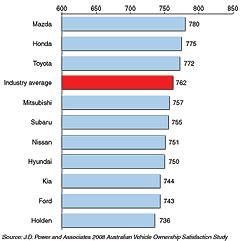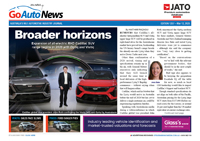News - General NewsMazda satisfies mostTwo good: Redesigned Mazda2 was launched here last year. JD Power’s first Australian car ownership satisfaction survey reveals surprise results19 Feb 2008 By JOHN MELLOR and MARTON PETTENDY JAPANESE car-makers, led by Mazda, have made a clean-sweep of the top three positions in the inaugural JD Power and Associates Australian Vehicle Ownership Satisfaction Study released today (February 20). JD Power’s 2008 customer satisfaction survey aims to objectively measure new-vehicle ownership satisfaction in Australia over the first three years of ownership. Mazda tops the list with an overall index score of 780 points on a 1000-point scale, while Honda (775) and Toyota (772) fill out the top three overall ownership satisfaction rakings. All three Japanese brands scored well above the industry average of 762, while rounding out the top ten were Mitsubishi (757), Subaru (755), Nissan (751), Hyundai (750), Kia (744), Ford (743) and Holden (736). JD Power says the 2008 AVOSS is a new benchmark for measuring customer attributes and expectations in the Australian automotive industry.  Left: J.D. Power and Associates 2008 Australian Vehicle Ownership Satisfaction Study Overall Nameplate Ranking (based on a 1000-point scale). Left: J.D. Power and Associates 2008 Australian Vehicle Ownership Satisfaction Study Overall Nameplate Ranking (based on a 1000-point scale).The overall satisfaction rating is determined by a combination of weighted scores in four areas of customer experience: dealership service satisfaction, which carries the lightest weighting at 18.7 per cent vehicle quality and reliability, which carries a 21.7 per cent weighting ownership costs, which carries a 25.8 per cent weighting and vehicle appeal (satisfaction with the design, style, performance and comfort of the vehicle), which carries the heaviest weighting at 33.8 per cent. Specifically, JD Power says the dealership service component of the survey (19%) covers both maintenance and repair work, and includes 29 attributes related to franchised dealership service, initiating the service visit, service advisor, dealership facility, picking up vehicle after service and service quality. The vehicle quality and reliability section (22%) relates to customer satisfaction with the vehicle’s overall quality and day-to-day reliability. It is based on a single rating of vehicle quality/reliability with 90 diagnostic problem symptoms reported as problems per 100 vehicles. Ownership cost issues (26%) relate to servicing and repairs, fuel consumption, while vehicle appeal (34%) covers satisfaction across eight vehicle attributes including design, style, performance and comfort. The results were based on responses from 3078 new-vehicle owners. The full report, which is now on sale to the industry at a cost of $28,000 (excluding GST), comprises data on most other brands, including Alfa Romeo, Audi, BMW, Chrysler, Citroen, Daihatsu, Fiat, Jaguar, Jeep, Land Rover, Lexus, Mercedes-Benz, Peugeot, Renault, Saab, Suzuki, Volkswagen and Volvo. However, these brands are not included in the overall results released to GoAuto because the samples for lower-volume brands in the market are smaller. The managing director of JD Power and Associates Australia and New Zealand, Brian Fine, said that while Mazda performed particularly well in the quality/reliability and vehicle appeal areas, it was not the best brand in the area of ownership costs. In fact, it was not in the top three. Nor was it in the top three on dealership service. Yet its strengths in vehicle appeal and in quality and reliability allowed it to creep ahead of Honda on the overall top score. “Mazda’s strong performance in the inaugural study sets a benchmark for other manufacturers in the Australian market,” said Mr Fine, who added that the result for the top three was very close. “A difference of eight in the score of the top three brands was marginal in an overall score of 1000. Honda and Toyota also perform well and rank among the top three, indicating that Japanese auto-makers in particular are succeeding in satisfying new-vehicle owners in Australia.” Commenting on Toyota, which usually wins JD Power quality surveys, Mr Fine said Toyota was strong on quality but fell below Mazda and Honda on appeal. He said Toyota performed well in the area of service (in a tie with Nissan), as well as in ownership costs. He said Honda was consistently strong across all categories, but did not top any of them. However, this was enough to secure second place overall. Mitsubishi came fourth. The timing of the report and the good showing for the company is an important result for Mitsubishi, which is now managing the transition from local manufacturing to total imports. Mr Fine said Mitsubishi was middling on quality and reliability, middling on cost and middling on appeal but did much better on dealership service. “So it was able to keep its end up across the board,” he said. Mr Fine said Kia’s performance in the survey was due to its strength in the area of ownership cost. “This is why it sits above Ford and Holden in the overall rankings. Kia was well up on costs but it was not there on service. It was above Holden on quality and reliability but below Ford. “But Ford and Holden had greater appeal in their vehicles than Kia. So basically, value-for-money is the key driver for Kia. “Hyundai’s big strengths were certainly not on the quality side but it is definitely up there on the cost side. That is its strength,” he said. |
Click to shareGeneral News articlesResearch General News Motor industry news |














Facebook Twitter Instagram